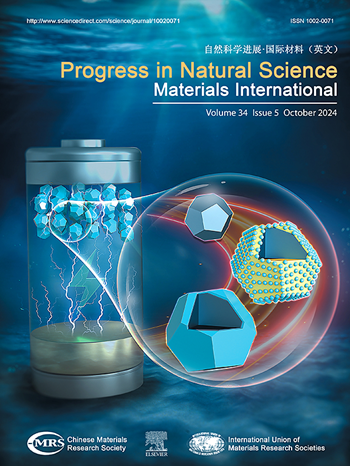Balancing charge carrier density and exciton recombination in defective g-C3N4 for efficient photocatalytic hydrogen evolution
IF 7.1
2区 材料科学
Q2 MATERIALS SCIENCE, MULTIDISCIPLINARY
Progress in Natural Science: Materials International
Pub Date : 2025-02-01
DOI:10.1016/j.pnsc.2024.12.015
引用次数: 0
Abstract
Graphitic carbon nitride (g-C3N4) is a promising material for photocatalytic hydrogen production owing to its tunable band structure and high charge carrier density, however, it displays a high carrier recombination rate. Defect engineering can solve this problem by providing active sites within g-C3N4 to accelerate the separation of photogenerated electrons and holes and enhance its solar light absorption. Previous studies have implied that there exists a defect concentration threshold for obtaining the maximum photocatalytic hydrogen production performance, but the underlying mechanism remains unclear. In this study, the relationship between charge carrier density and exciton recombination was investigated to address this issue. A series of g-C3N4 photocatalysts with different tri-coordinate nitrogen (N3C) vacancy concentrations were synthesized using in-situ coprecipitation polymerization. The catalytic performance is related to the vacancy concentration, higher vacancy concentration will lead to higher carrier separation efficiency and carrier density of g-C3N4, as well as better photocatalytic hydrogen production performance. However, when excessive vacancies act as recombination centers, the charge carrier recombination rate is increased, which will also adversely affect the photocatalytic hydrogen production performance.

平衡缺陷g-C3N4的载流子密度和激子重组以实现高效光催化析氢
石墨化氮化碳(g-C3N4)由于其能带结构可调、载流子密度高,是一种很有前途的光催化制氢材料,但其载流子复合率高。缺陷工程可以通过在g-C3N4内部提供活性位点来加速光电子与空穴的分离,增强其对太阳光的吸收,从而解决这一问题。以往的研究表明,获得最大光催化制氢性能存在缺陷浓度阈值,但其潜在机制尚不清楚。为了解决这一问题,本文研究了载流子密度与激子复合的关系。采用原位共沉淀法合成了一系列具有不同三坐标氮空位浓度的g-C3N4光催化剂。催化性能与空位浓度有关,空位浓度越高,g-C3N4的载流子分离效率和载流子密度越高,光催化制氢性能越好。然而,当过多的空位作为复合中心时,载流子的复合速率会增加,这也会对光催化制氢性能产生不利影响。
本文章由计算机程序翻译,如有差异,请以英文原文为准。
求助全文
约1分钟内获得全文
求助全文
来源期刊
CiteScore
8.60
自引率
2.10%
发文量
2812
审稿时长
49 days
期刊介绍:
Progress in Natural Science: Materials International provides scientists and engineers throughout the world with a central vehicle for the exchange and dissemination of basic theoretical studies and applied research of advanced materials. The emphasis is placed on original research, both analytical and experimental, which is of permanent interest to engineers and scientists, covering all aspects of new materials and technologies, such as, energy and environmental materials; advanced structural materials; advanced transportation materials, functional and electronic materials; nano-scale and amorphous materials; health and biological materials; materials modeling and simulation; materials characterization; and so on. The latest research achievements and innovative papers in basic theoretical studies and applied research of material science will be carefully selected and promptly reported. Thus, the aim of this Journal is to serve the global materials science and technology community with the latest research findings.
As a service to readers, an international bibliography of recent publications in advanced materials is published bimonthly.

 求助内容:
求助内容: 应助结果提醒方式:
应助结果提醒方式:


